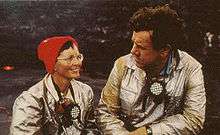Katia and Maurice Krafft
| Katia and Maurice Krafft | |
|---|---|
 Katia and Maurice Krafft | |
| Born |
April 17, 1942 (Katia), March 25, 1946 (Maurice) |
| Died |
June 3, 1991 (aged 49) (Katia) June 3, 1991 (aged 45) (Maurice) Mount Unzen, Japan |
| Cause of death | Killed by the 1991 eruption of Mt. Unzen |
| Nationality | French |
Katia Krafft (née Catherine Joséphine Conrad, Mulhouse, 17 April 1942 – 3 June 1991) and her husband, Maurice Paul Krafft (Guebwiller, 25 March 1946 – 3 June 1991), were French volcanologists who died in a pyroclastic flow on Mount Unzen, in Japan, on June 3, 1991. The Kraffts were known for being pioneers in filming, photographing and recording volcanoes, often getting within feet of lava flows. Their obituary appeared in the Bulletin of Volcanology (vol. 54, pp. 613–614).
Early days
Katia Conrad and Maurice Krafft met at the University of Strasbourg, and their career as volcano observers began soon after. With little money, they saved up for a trip to Stromboli and photographed its near-continuous eruption. Finding that people were interested in this documentation of eruptions, they soon made a career out of this, which afforded them the ability to travel the globe. They were married in 1970.
As professional volcanologists
The Kraftts were often the first to be at an active volcano, and were respected and envied by many volcanologists. Their footage of the effects of volcanic eruptions was a considerable factor in gaining the cooperation of local authorities faced with volcanic threats. One notable example of this was after the onset of activity at Mount Pinatubo in 1991, where their video of the effects of the eruption of Nevado del Ruiz in Colombia was shown to large numbers of people, including Philippine President Cory Aquino, and convinced many skeptics that evacuation of the area would be necessary.
The Mount Unzen eruption
In June 1991, while filming eruptions at Mount Unzen (Japan), they were caught in a pyroclastic flow which unexpectedly swept out of the channel that previous smaller flows had been following and onto the ridge they were standing on. They were killed instantly along with 41 people, including fellow volcanologist Harry Glicken, several firemen, and journalists also covering the eruptions.
The work of the Kraffts was highlighted in a video issue of National Geographic, which contained a large amount of their film footage and photographs as well as interviews with both. Maurice famously says in that video that "I am never afraid because I have seen so many eruptions in 23 years that even if I die tomorrow, I don't care", coincidentally on the day before his, and his wife's death at Mt. Unzen.[1]
M. and K. Krafft Crater
A volcanic crater, M. and K. Krafft Crater, of the volcano Piton de la Fournaise on the island of Reunion, is named after Maurice and Katia Krafft. The crater is located at 21°13′23″S 55°43′2″E / 21.22306°S 55.71722°E.[2] Lava erupted from this crater in March 1998.[3]
Books
Maurice Krafft
- Guide des volcans d’Europe : généralités, France, Islande, Italie, Grèce, Allemagne..., Neuchâtel: Delachaux et Niestlé, 1974, 412 pp.
- Questions à un vulcanologue : Maurice Krafft répond, Paris: Hachette-Jeunesse, 1981, 231 pp.
- Les Volcans et leurs secrets, Paris: Nathan, 1984, 63 pp.
- Le Monde merveilleux des volcans, Paris: Hachette-Jeunesse, 1981, 58 pp.
- Les Feux de la Terre, Histoire de volcans, Paris: Découvertes Gallimard, 208 pp.
Maurice and Katia Krafft
- À l’assaut des volcans, Islande, Indonésie, Paris: Presses de la Cité, 1975, 112 pp.
- Preface by Eugène Ionesco, Les Volcans, Paris: Draeger-Vilo, 1975, 174 pp.
- La Fournaise, volcan actif de l’île de la Réunion, Saint-Denis: Éditions Roland Benard, 1977, 121 pp.
- Volcans, le réveil de la Terre, Paris: Hachette-Réalités, 1979, 158 pp.
- Dans l’antre du Diable : volcans d’Afrique, Canaries et Réunion, Paris: Presses de la Cité, 1981, 124 pp.
- Volcans et tremblements de terre, Paris: Les Deux Coqs d’Or, 1982, 78 pp.
- Volcans et dérives des continents, Paris: Hachette, 1984, 157 pp.
- Les plus beaux volcans, d’Alaska en Antarctique et Hawaï, Paris: Solar, 1985, 88 pp.
- Volcans et éruptions, Paris: Hachette-Jeunesse, 1985, 90 pp.
- Les Volcans du monde, Vevey-Lausanne: Éditions Mondo, 1986, 152 pp.
- Objectif volcans, Paris: Nathan Image, 1986, 154 pp.
- Führer zu den Virunga Vulkanen, Stuttgart: F. Enke, 1990, 187 pp.
Maurice Krafft and Roland Benard
- Au cœur de la Fournaise, Orléans: Éditions Nourault-Bénard, 1986, 220 pp.
Maurice Krafft, Katia Krafft and François-Dominique de Larouzière
- Guide des volcans d'Europe et des Canaries, Neuchâtel: Delachaux et Niestlé, 1991, 455 pp.
References
- ↑ Volcano: Nature's Inferno (videorecording). Washington, DC: National Geographic Society. 2003.
- ↑ Bachelery, P., Lenat, J-F., Di Muro, A. and Michon, L. (editors) (2016). Active Volcanoes of the Southwest Indian Ocean: Piton de la Fournaise and Katharla. Berlin: Springer. p. 146. ISBN 978-3-642-31394-3.
- ↑ "Activité historique du Piton de la Fournaise". Observatoire volcanologique du Piton de la Fournaise. Retrieved 3 June 2016.
- P.B.S. Nature: "The Volcano Watchers" 60 minute VHS tape [PBS 103] WNET THirteen Copyright 1987, ISBN 1-56111-504-5
- National Geographic Society "Volcano" 60 minute VHS tape [52763] Columbia Tristar Home Video ISBN 0-8001-2666-1
External links
- (French) Images de volcans, Pictures, videos and sounds, taken by Maurice and Katia Krafft, and biography
- Mt. Unzen dome collapse triggers the pyroclastic flow that takes the lives of Maurice and Katia Craft on YouTube
- Katia Krafft at Library of Congress Authorities, with 9 catalogue records
- Maurice Krafft at Library of Congress Authorities, with 11 catalogue records